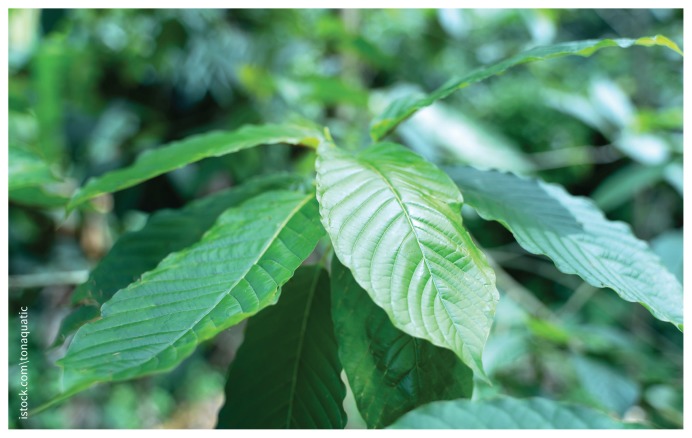Kratom (Mitragyna speciosa Korth.) is a herbal product from Southeast Asia with opioid agonist properties
Kratom is a herbal product that is most commonly obtained as a powder and consumed as a beverage.1–3 Kratom contains the indole alkaloid compounds mitragynine and 7-hydroxymitragynine, which are opioid receptors agonists.2,3 They reduce pain, cause dose-dependent stimulant and sedative effects, and have an adverse effect profile consistent with opioid activity.2 Kratom is not detected on conventional urine drug-screening tests.2
Kratom use is increasing
Avoidance of drug withdrawal, treatment of chronic pain and recreation are common reasons for kratom use.1,2 American poison centres saw an increase in kratom-related calls, from 18 exposures in 2011 to 357 in the first 7 months of 2018.4 The US Centers for Disease Control and Prevention identified 91 cases in which kratom was identified as a potential cause of death from July 2016 to December 2017.5
Effects of kratom use appear to be dose dependent
Kratom use is associated with stimulant effects at low doses (1–5 g), and sedative effects at higher doses (5–15 g).2 Negative adverse effects most commonly include gastrointestinal symptoms and agitation, and are reported to be dose dependent.1,4
Kratom users may experience withdrawal with cessation
Moderate to heavy daily users of kratom (≥ 3 doses/d) commonly have cravings and withdrawal symptoms similar to those of opioid withdrawal with cessation.2,5 Of kratom users, 43% reported negative adverse events if they abstained for more than 48 hours.1
Management of kratom ingestion is supportive
Doses in excess of 15 g may mimic an opioid toxidrome. Naloxone should be given for drowsiness and respiratory depression.3 Severe adverse events, including death, have been reported with kratom use in conjunction with opioids, benzodiazepines, modafinil and other medications.2,5 Supportive management and toxicology consultation are indicated for cases of overdose or intoxication.
Image courtesy of istock.com\tonaquatic
Footnotes
Competing interests: None declared.
This article has been peer reviewed.
References
- 1.Grundmann O. Patterns of kratom use and health impact in the US — results from an online survey. Drug Alcohol Depend 2017;176:63–70. [DOI] [PubMed] [Google Scholar]
- 2.Warner ML, Kaufman NC, Grundmann O. The pharmacology and toxicology of kratom: from traditional herb to drug of abuse. Int J Legal Med 2016;130:127–38. [DOI] [PubMed] [Google Scholar]
- 3.Rosenbaum CD, Carreiro SP, Babu KM. Here today, gone tomorrow … and back again? A review of herbal marijuana alternatives (K2, Spice), synthetic cathinones (bath salts), kratom, salvia divinorum, methoxetamine, and piperazines. J Med Toxicol 2012;8:15–32. [DOI] [PMC free article] [PubMed] [Google Scholar]
- 4.Eggleston W, Stoppacher R, Suen K, et al. Kratom use and toxicities in the United States. Pharmacotherapy 2019;39:775–7. [DOI] [PubMed] [Google Scholar]
- 5.Olsen EO, O’Donnell J, Mattson CL, et al. Unintentional drug overdose deaths with kratom detected — 27 states, July 2016–December 2017. MMWR Morb Mortal Wkly Rep 2019;68:326–7. [DOI] [PMC free article] [PubMed] [Google Scholar]



